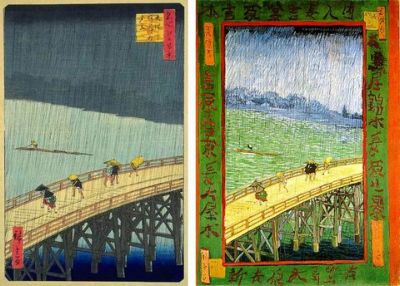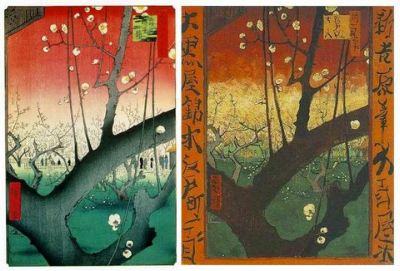 Japonisme is a French word used in the middle to late 1800’s to describe the impact of Japanese art on Western art. In 1854 japan began trading again with western countries after 216 years of alienation (see ‘Treaty of Kanagawa” below) Japanese art, including ceramics (porcelains), woodcuts and screens quickly became very popular, particularly in the Netherlands and France. The European World Fair of 1862 together with the Paris Exposition Universelle in1867 featured significant presentations of Japanese art. Western Impressionist artists including Monet, Degas, Gauguin and Van Gogh were influenced by these displays. Van Gogh in particular admired Ukiyo-e, Japanese wood-block prints. Japanese art, including ceramics (porcelains), woodcuts and screens quickly became very popular, particularly in the Netherlands and France.In 1886 Vincent Van Gogh (1853-1890) moved to Paris and in 1887 painted copies of works by renowned landscape printmaker Utagawa Hiroshige (1797-1858).
Japonisme is a French word used in the middle to late 1800’s to describe the impact of Japanese art on Western art. In 1854 japan began trading again with western countries after 216 years of alienation (see ‘Treaty of Kanagawa” below) Japanese art, including ceramics (porcelains), woodcuts and screens quickly became very popular, particularly in the Netherlands and France. The European World Fair of 1862 together with the Paris Exposition Universelle in1867 featured significant presentations of Japanese art. Western Impressionist artists including Monet, Degas, Gauguin and Van Gogh were influenced by these displays. Van Gogh in particular admired Ukiyo-e, Japanese wood-block prints. Japanese art, including ceramics (porcelains), woodcuts and screens quickly became very popular, particularly in the Netherlands and France.In 1886 Vincent Van Gogh (1853-1890) moved to Paris and in 1887 painted copies of works by renowned landscape printmaker Utagawa Hiroshige (1797-1858).
One was “The Bridge in the Rain” and the other “Plum Tree in Bloom” Van Gogh’s fascination with Japanese prints continued to influence some of his paintings to the end of his life.
Foot-note
From 1639 AD to 1853 AD Japan closed its doors to communication and commerce with all outsiders, particularly of the western world, but with the exception of Holland and Germany. This period was known as the ‘Tokugawa Seclusion’. Shipbuilding was discontinued and Japanese citizens rarely visited other countries. However, the U.S.A saw the lucrative potential of a fully functioning trade system that included Japan. To encourage japan to once again open its borders to international trade the U.S.A, in 1853, sent Commodore Mathew Perry and his ‘Black Ships’ , 4 steam driven war ships, into Edo Bay. Japanese leaders had never before seen such a display of naval power and after discussions were held with the Bakufu, agreed to sign the ‘ Treaty of Peace and Amity’ on March31, 1854 (also known as the ‘ Treaty of Kanagawa’).

Under this treaty, Japan opened two ports, Shimoda and Hakodate, to U.S. ships seeking fuel and fresh provisions. It also guaranteed good care and safety for shipwrecked American sailors and a U.S. consul was allowed to stay in Shimoda. Soon after the ‘Treaty of Kanagawa’, the British, Russians, Dutch and French signed treaties with Japan. Thus ended the period of seclusion for Japan and saw the beginning of the era of Japonisme.
